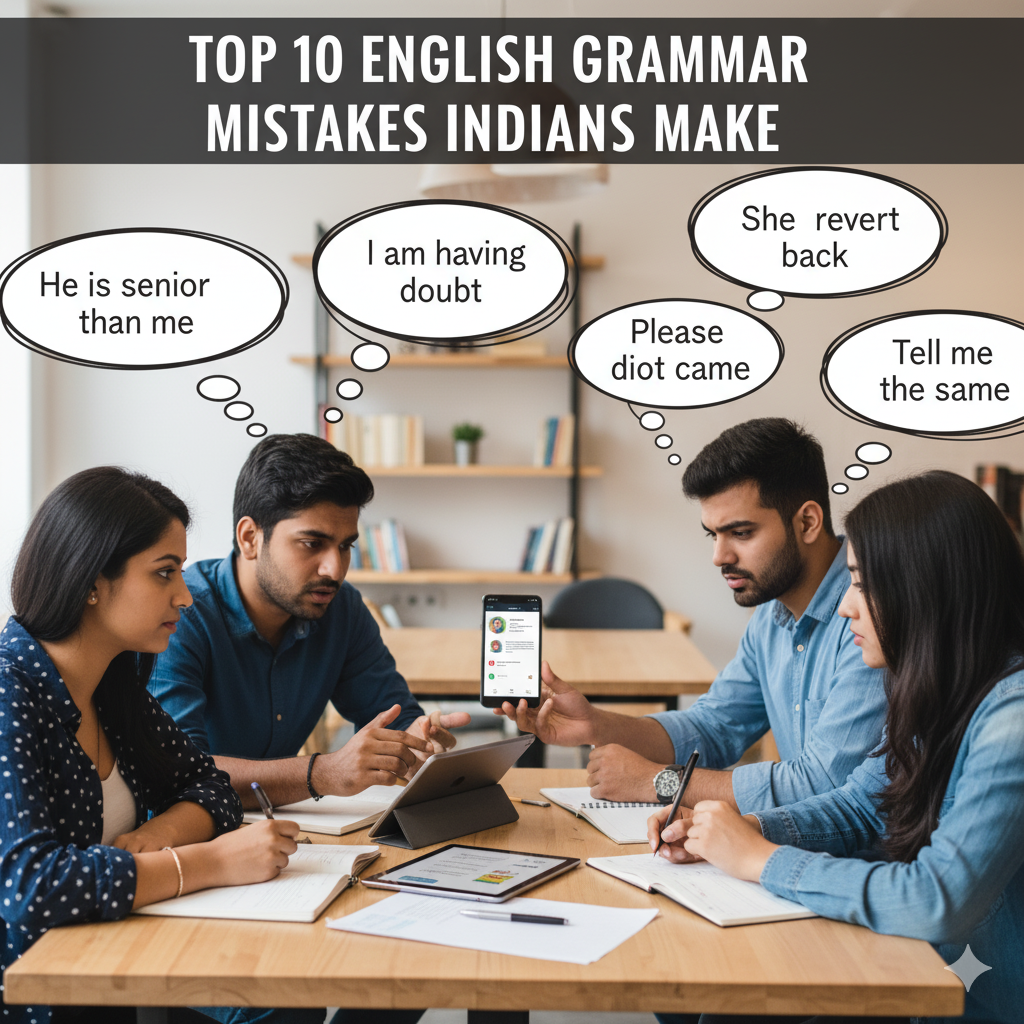
Discover the top English grammar mistakes Indians make and how to fix them for better communication and confidence.
English is a language that connects the world, but even fluent speakers often trip over its rules. In India, many people speak English confidently but still make some common grammar mistakes that can change the meaning of a sentence or make communication confusing. Do you ever find yourself unsure whether to say “He go” or “He goes”? Or maybe you wonder why “between you and I” feels correct, even though it isn’t?
In this article, we’ll explore the Top 10 English Grammar Mistakes Indians Make, why they happen, and how to avoid them. We’ll keep it simple, engaging, and easy to remember so you can improve your English without feeling overwhelmed.
Table of Contents
| Sr# | Headings |
|---|---|
| 1 | Using “He/She/It” Wrong |
| 2 | Confusing “Much” and “Many” |
| 3 | Misusing Prepositions |
| 4 | Wrong Tense Usage |
| 5 | Subject-Verb Agreement Errors |
| 6 | Double Negatives |
| 7 | Confusing “Between” and “Among” |
| 8 | Incorrect Use of Articles |
| 9 | Misplacing Adverbs |
| 10 | Using “I” and “Me” Incorrectly |
| 11 | Overusing “Very” and “Really” |
| 12 | Mixing Up “Who” and “Whom” |
| 13 | Improper Pluralization |
| 14 | Confusing “Since” and “For” |
1. Using “He/She/It” Wrong
One of the most common mistakes is forgetting to use the correct verb with third-person singular subjects. For example:
- ❌ He go to school every day.
- ✅ He goes to school every day.
The simple trick is to remember: he, she, it = add ‘s’ to the verb in present simple tense.
Think of it like a lock and key: the ‘s’ fits perfectly with the subject. Without it, your sentence feels incomplete.
2. Confusing “Much” and “Many”
Indians often use “much” and “many” interchangeably, but they are not the same:
- ❌ I have much friends.
- ✅ I have many friends.
- ❌ How many water do you drink?
- ✅ How much water do you drink?
Rule of thumb:
- Much → uncountable nouns
- Many → countable nouns
3. Misusing Prepositions
Prepositions like on, in, at, to, for are tricky. A small slip can confuse the listener:
- ❌ I am good in cooking.
- ✅ I am good at cooking.
- ❌ She is going to home.
- ✅ She is going home.
Think of prepositions as glue connecting ideas. The wrong glue, and your sentence falls apart.
4. Wrong Tense Usage
Switching tenses mid-sentence is common:
- ❌ I eat breakfast yesterday.
- ✅ I ate breakfast yesterday.
- ❌ She is going to school yesterday.
- ✅ She went to school yesterday.
Tip: Always check your time reference—past, present, or future—before choosing the verb.
5. Subject-Verb Agreement Errors
A frequent mistake is mismatch between subject and verb:
- ❌ The team are winning the match.
- ✅ The team is winning the match.
Tip: Singular subjects take singular verbs; plural subjects take plural verbs.
6. Double Negatives
Double negatives create confusion and are grammatically incorrect:
- ❌ I don’t know nothing.
- ✅ I don’t know anything.
Remember: two negatives make a positive in English grammar. Keep it simple.
7. Confusing “Between” and “Among”
- ❌ Distribute the gifts among you and me.
- ✅ Distribute the gifts between you and me.
- ❌ He shared his secret between friends.
- ✅ He shared his secret among friends.
Rule: Use between for two things, among for more than two.
8. Incorrect Use of Articles
Indian English speakers often skip or misuse a, an, the:
- ❌ I bought apple.
- ✅ I bought an apple.
- ❌ The sun rises in a east.
- ✅ The sun rises in the east.
Think of articles as the tiny tools that give your sentence polish.
9. Misplacing Adverbs
Adverbs describe verbs, adjectives, or other adverbs, but their placement matters:
- ❌ She quickly runs to school.
- ✅ She runs quickly to school.
- ❌ I have only five rupees.
- ✅ I only have five rupees.
A misplaced adverb can completely change the meaning—like putting sugar in salt!
10. Using “I” and “Me” Incorrectly
Many Indians say:
- ❌ Between you and I
- ✅ Between you and me
Tip: If you remove the other person, what sounds correct?
- ❌ Between I → ❌
- ✅ Between me → ✅
11. Overusing “Very” and “Really”
While these words emphasize, overusing them weakens your writing:
- ❌ She is very very smart.
- ✅ She is extremely smart.
Use strong adjectives instead of piling on adverbs.
12. Mixing Up “Who” and “Whom”
- ❌ Whom is coming to the party?
- ✅ Who is coming to the party?
- ❌ Who did you speak with?
- ✅ You spoke with whom?
Rule: Who → subject, Whom → object.
13. Improper Pluralization
- ❌ She has three childs.
- ✅ She has three children.
- ❌ I saw many sheeps.
- ✅ I saw many sheep.
English has irregular plurals. Memorize the common ones.
14. Confusing “Since” and “For”
- ❌ I have lived here since five years.
- ✅ I have lived here for five years.
- ❌ I have known him for 2015.
- ✅ I have known him since 2015.
Tip: Use since for starting point, for for duration.
Conclusion
Mastering English grammar takes practice, but by being aware of these Top 10 (plus extra) mistakes Indians make, you can avoid common pitfalls and communicate more clearly. Remember, grammar is not about perfection; it’s about clarity and confidence. With consistent practice, these mistakes will soon become a thing of the past.
FAQs
1. Why do Indians often make English grammar mistakes?
Many Indians learn English as a second language, and local languages influence sentence structure and vocabulary usage.
2. Can I improve my grammar quickly?
Yes, regular reading, writing, and paying attention to common mistakes can improve grammar fast.
3. Are these mistakes only common in India?
Some mistakes are universal, but these particular ones are especially prevalent among Indian English speakers.
4. Should I focus on spoken or written English first?
Focus on both, but starting with spoken English can boost confidence and make written English easier.
5. Are grammar apps useful for learning?
Yes, apps like Grammarly or Duolingo help correct mistakes, but practicing regularly is key.







